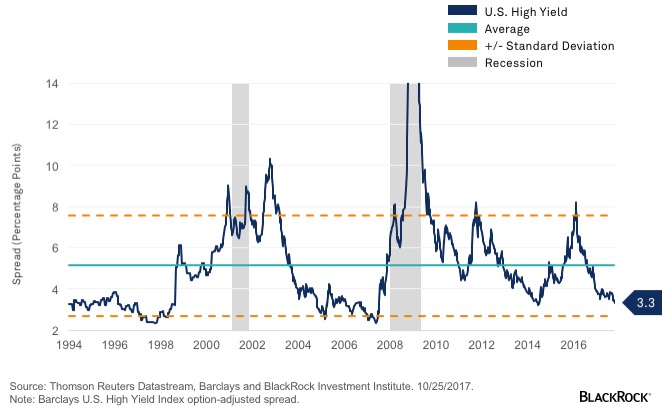by Russ Koesterich, Portfolio Manager, Blackrock
High yield bonds have been investor favorite the last year and a half. Russ discusses why that may not last.
Equities are not the only asset class defying gravity these days. The past 18 months have witnessed stellar performance from most risky assets, including U.S. high yield. With the economy on solid footing and financial conditions still relatively loose, investors are relying on several arguments that this happy state of affairs will continue:
Momentum
2017 has been a year dominated by momentum trades, such as high yield. Barclays High Yield Index returned approximately 17% in 2016. Depending on the index you use, it is up another 6% to 7% in 2017. In short, investors have done extremely well sticking with this trade.
Yield in a yield-starved world
The yield on U.S. high yield has slipped as spreads have compressed. At 5%, high yield does not seem to offer particularly generous returns, especially when you consider that the long-term average is closer to 10%. Still, a 5% yield looks enticing given the alternatives in other bonds.
Low Volatility
As with stocks, high yield bonds have had a remarkably quiet year. According to Bloomberg, trailing 30-day volatility on two popular high yield ETFs is below 3%. Longer-term measures of volatility are also compressed. This is important. Low expected or ex-ante volatility historically translates into a high expected Sharpe Ratio. In other words, with realized and expected volatility unusually low, high yield appears attractive on a risk/return basis.
What could lead to a less benign outcome? As it turns out, a number of things, although admittedly none are likely to derail the asset class in the near term. However, those with a longer-term horizon should take note of historically tight spreads, rising corporate debt and lower credit quality.
Tight spreads
The first problem is that high yield is expensive, arguably very expensive.
The spread that investors are currently receiving, i.e. yield above a comparable maturity Treasury, is unusually small. Since bond yields move down when the price of the bond goes up, this is usually a sign the bonds are getting pricey. How much? Since 1994 the average spread has been approximately 515 basis points (or 5.15 percentage points). Today the spread is around 350 bps. This is the lowest level in more than three years. Current levels are also starting to approach the lows witnessed just before the financial crisis. See the accompanying chart.
U.S. high yield
Rising debt, lower quality
The second problem is that companies are taking on more debt. Since 2010, U.S. corporate debt has been growing at an annualized rate of more than 5.5%. While debt servicing costs are still low, overall corporate debt is now close to its post-war peak. Higher interest rates would pressure many issuers and raise the future default rate.
Finally, not only is there more corporate debt, an increasing percentage of it is low quality. CCC issuance, the lowest tranche of the high yield segment, is once again growing as a percentage of total issuance. This trend generally precedes widening spreads and returns, as was the case during the 2015-2016 mini-selloff in high yield.
While I don’t see another recession or surging yields on the immediate horizon, tight spreads, more debt, lower quality debt and less accommodative monetary conditions are not a winning combination. For now, I would look to trim back high yield and consider a combination of higher quality equities leavened with some Treasuries to help mitigate volatility.
Russ Koesterich, CFA, is Portfolio Manager for BlackRock’s Global Allocation team and is a regular contributor to The Blog.
Copyright © Blackrock














